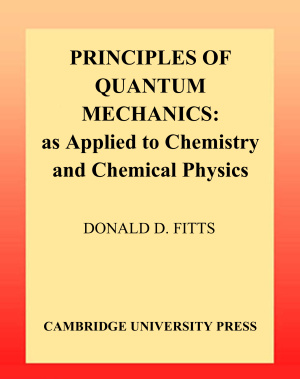Cambridge University Press, 2002. - 352 p.
This text presents a rigorous mathematical account of the principles of quantum mechanics, in particular as applied to chemistry and chemical physics. Applications are used as illustrations of the basic theory.
The first two chapters serve as an introduction to quantum theory, although it is assumed that the reader has been exposed to elementary quantum mechanics as part of an undergraduate physical chemistry or atomic physics course.Following a discussion of wave motion leading to Schro?dinger's wave mechanics, the postulates of quantum mechanics are presented along with the essential mathematical concepts and techniques. The postulates are rigorously applied to the harmonic oscillator, angular momentum, the hydrogen atom, the variation method, perturbation theory, and nuclear motion. Mode theoretical concepts such as hermitian operators, Hilbert space, Dirac notation, and ladder operators are introduced and used throughout.
This advanced text is appropriate for beginning graduate students in chemistry, chemical physics, molecular physics, and materials science.
Contents
Preface
The wave function
Wave motion
Wave packet
Dispersion of a wave packet
Particles and waves
Heisenberg uncertainty principle
Young's double-slit experiment
Ste±Gerlach experiment
Physical interpretation of the wave function
Problems
Schro?dinger wave mechanics
The Schro?dinger equation
The wave function
Expectation values of dynamical quantities
Time-independent Schro?dinger equation
Particle in a one-dimensional box
Tunneling Particles in three dimensions
Particle in a three-dimensional box
Problems
General principles of quantum theory
Linear operators
Eigenfunctions and eigenvalues
Hermitian operators
Eigenfunction expansions
Simultaneous eigenfunctions
Hilbert space and Dirac notation
Postulates of quantum mechanics
Parity operator
Hellmann – Feynman theorem
Time dependence of the expectation value
Heisenberg uncertainty principle
Problems
Harmonic oscillator
Classical treatment
Quantum treatment
Eigenfunctions
Matrix elements
Heisenberg uncertainty relation
Three-dimensional harmonic oscillator
Problems
Angular momentum
Orbital angular momentum
Generalized angular momentum
Application to orbital angular momentum
The rigid rotor
Magnetic moment
Problems
The hydrogen atom
Two-particle problem
The hydrogen-like atom
The radial equation
Atomic orbitals
Spectra
Problems
Spin
Electron spin
Spin angular momentum
Spin one-half
Spin – orbit interaction
Problems
Systems of identical particles
Permutations of identical particles
Bosons and fermions
Completeness relation
Non-interacting particles
The free-electron gas
Bose – Einstein condensation
Problems
Approximation methods
Variation method
Linear variation functions
Non-degenerate perturbation theory
Perturbed harmonic oscillator
Degenerate perturbation theory
Ground state of the helium atom
Problems
Molecular structure
Nuclear structure and motion
Nuclear motion in diatomic molecules
Problems
Appendix A Mathematical formulas
Appendix B Fourier series and Fourier integral
Appendix C Dirac delta function
Appendix D Hermite polynomials
Appendix E Legendre and associated Legendre polynomials
Appendix F Laguerre and associated Laguerre polynomials
Appendix G Series solutions of differential equations
Appendix H Recurrence relation for hydrogen-atom expectation values
Appendix I Matrices
Appendix J Evaluation of the two-electron interaction integral
Selected bibliography
Index
Physical constants
This text presents a rigorous mathematical account of the principles of quantum mechanics, in particular as applied to chemistry and chemical physics. Applications are used as illustrations of the basic theory.
The first two chapters serve as an introduction to quantum theory, although it is assumed that the reader has been exposed to elementary quantum mechanics as part of an undergraduate physical chemistry or atomic physics course.Following a discussion of wave motion leading to Schro?dinger's wave mechanics, the postulates of quantum mechanics are presented along with the essential mathematical concepts and techniques. The postulates are rigorously applied to the harmonic oscillator, angular momentum, the hydrogen atom, the variation method, perturbation theory, and nuclear motion. Mode theoretical concepts such as hermitian operators, Hilbert space, Dirac notation, and ladder operators are introduced and used throughout.
This advanced text is appropriate for beginning graduate students in chemistry, chemical physics, molecular physics, and materials science.
Contents
Preface
The wave function
Wave motion
Wave packet
Dispersion of a wave packet
Particles and waves
Heisenberg uncertainty principle
Young's double-slit experiment
Ste±Gerlach experiment
Physical interpretation of the wave function
Problems
Schro?dinger wave mechanics
The Schro?dinger equation
The wave function
Expectation values of dynamical quantities
Time-independent Schro?dinger equation
Particle in a one-dimensional box
Tunneling Particles in three dimensions
Particle in a three-dimensional box
Problems
General principles of quantum theory
Linear operators
Eigenfunctions and eigenvalues
Hermitian operators
Eigenfunction expansions
Simultaneous eigenfunctions
Hilbert space and Dirac notation
Postulates of quantum mechanics
Parity operator
Hellmann – Feynman theorem
Time dependence of the expectation value
Heisenberg uncertainty principle
Problems
Harmonic oscillator
Classical treatment
Quantum treatment
Eigenfunctions
Matrix elements
Heisenberg uncertainty relation
Three-dimensional harmonic oscillator
Problems
Angular momentum
Orbital angular momentum
Generalized angular momentum
Application to orbital angular momentum
The rigid rotor
Magnetic moment
Problems
The hydrogen atom
Two-particle problem
The hydrogen-like atom
The radial equation
Atomic orbitals
Spectra
Problems
Spin
Electron spin
Spin angular momentum
Spin one-half
Spin – orbit interaction
Problems
Systems of identical particles
Permutations of identical particles
Bosons and fermions
Completeness relation
Non-interacting particles
The free-electron gas
Bose – Einstein condensation
Problems
Approximation methods
Variation method
Linear variation functions
Non-degenerate perturbation theory
Perturbed harmonic oscillator
Degenerate perturbation theory
Ground state of the helium atom
Problems
Molecular structure
Nuclear structure and motion
Nuclear motion in diatomic molecules
Problems
Appendix A Mathematical formulas
Appendix B Fourier series and Fourier integral
Appendix C Dirac delta function
Appendix D Hermite polynomials
Appendix E Legendre and associated Legendre polynomials
Appendix F Laguerre and associated Laguerre polynomials
Appendix G Series solutions of differential equations
Appendix H Recurrence relation for hydrogen-atom expectation values
Appendix I Matrices
Appendix J Evaluation of the two-electron interaction integral
Selected bibliography
Index
Physical constants

